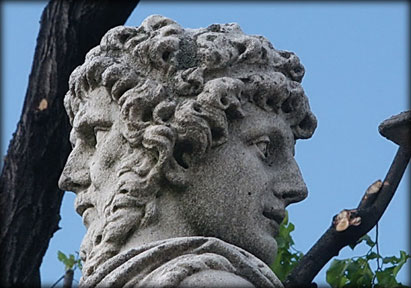|
Janus holds the key:
The dawn of a New Year
By Lionel Wijesiri
In three days, a New Year dawns. The ‘New Year’ has become so
fundamental that it’s almost as though nature ordained it. However, New
Year’s Day is a civil event. It isn’t precisely fixed by any natural
seasonal marker. On this day, there are no astrological changes of the
planets. There are no changes in the lunar pattern. History does not
even record the birth of any extraordinary leader. Then why do people
take this day as an important beginning of their lives?
 |
|
Janus, the Roman god is
depicted with two faces on opposite sides of his head |
Going back in history will help us to answer this question. Let us
take the first month – January. Most of us know that this month is named
after Janus. Traditionally, the original Roman calendar consisted of 10
months, from March to December, totalling 304 days, winter with 61 days
being considered a period without allocation of months. They were named
as Martius (31), Aprilis (30), Maius (31), Iunius (30), Quintiles (31),
Sextilis (30), September (30), October (31), November (30), December
(30).
The original Roman calendar was said to be invented by Romulus, the
first king of Rome, at around 753 BC. He organised the months around
three days, each of which served as a reference point for counting the
other days: Kalends (first day of the month): Nones (the seventh day in
March, May, July and October; the fifth in the other months): Ides (the
15th day in March, May, July, and October; the 13th in the other
months). The remaining, unnamed days of the month were identified by
counting backwards from the Kalends, Nones, or the Ides. For example,
March 3 would be V Nones (five days before the Nones).
The 304-day Roman calendar didn’t work for long because it didn’t
align with the seasons. King Numa Pompilius reformed the calendar around
700 BC by adding the months of January (Ianuarius) and February
(Februarius) to the original 10 months, which increased the year’s
length to 354 or 355 days. The month Quintilis was renamed July in
honour of Julius Caesar in 44 BCE and Sextilis was renamed August in
honour of Augustus in 8 BCE.
Divinity
Although various Christian feast dates were used for the New Year in
Europe during the Middle Ages, calendars were still much popular and
extensively used in the Roman fashion of 12 columns from January to
December. Beginning in the 16th century, European countries began
officially making January 1 the start of the New Year again.
The most ancient sites of what will later become the city of Rome, to
which we can trace the presence of people of which the most ancient
history narrates, are recognised in the heights of the Janiculum hill,
the Capitoline, the ancient Saturnia, and the Palatine and the ancient
Pallanteo.
Janiculum, the second highest hill in the contemporary city of Rome,
was believed to be the centre for the cult of the god Janus. Because of
its stunning location overlooking the city, it is said that the cult’s
priests would stand atop the hill and look for auspices or signs from
the gods.
On this hill, in a period much earlier than the Trojan War, there was
proof according to tradition, that Janus, at his death was made a god
and is still today remembered as the most important pagan divinity of
Rome. From his son, Tiberius, comes the name of the river of Rome, the
Tiber.
It was Janus who gave hospitality to the god Saturn, who settled on
the Capitoline hill, which at the time was, in fact, called Saturnia.
The Capitoline contains a few ancient ground-level ruins, as they are
almost entirely covered by medieval palaces (now the Capitoline
Museums).
Exclusively a Roman divinity, the origin of Janus is very ancient.
For some historians, he came from an ancient Arcadic king before the
Roman Empire; for others, even more ancient, Janus came from Thessaly,
an extensive Neolithic culture around 2500 BC.
The temple of Janus in Rome was situated in a street named Argiletum,
an important road that connected the Roman Forum and the residential
areas in the north east. Janus was surnamed divom deus, a very ancient
form of Latin meaning “the god’s god”; and his portrait can be found on
the oldest Roman coins.
Worship
The original worship of Janus must be ascribed to the Etruscans. The
Etruscan civilisation is the modern English name given to the culture of
a people of ancient Italy and Corsica whom the ancient Romans called
Etrusci. The civilisation endured from an unknown prehistoric time prior
to the founding of Rome until its complete assimilation to Rome in the
Roman Republic.
 |
|
The Temple of Janus, said to have been
consecrated by the consul Gaius Duilius in 260 BC |
Janus was regarded as the inspector of Heaven by the Etruscans, and
therefore of all transactions. An image of the god with four faces came
from Valerii to Rome, which is supposed to have reference to the four
regions of Heaven.
In Rome, he was usually represented with two faces, one before and
one behind. There was an ancient statue of this deity in the Forum,
which is located between the Palatine hill and the Capitoline hill of
the city. It is said to be as old as the time of Numa Pompilius (753–673
BC) who was the legendary second king of Rome, succeeding Romulus. The
fingers of one hand were so formed representing 300 (CCC) and those of
the other 55 (LV), the number of the days of the ancient lunar year.
Janus was always invoked at the commencement of most actions; even in
the worship of the other gods, the votary began by offering wine and
incense to him. He was regarded as the key to open the day and year.
Similar gods
Even today, under these and similar points of view, Janus reveals
himself to us as exactly similar to the gods of the year in the
Egyptian, Persian and Phoenician mythologies. Like Osiris, Heracles,
Baal and others, he represents the year personified in its development
through the 12 signs of the zodiac.
On New Year’s Day, which was the principal festival of Janus, people
took care that all they thought, said, and did, was pure and favourable.
People wore festive garments, abstained from cursing and quarrelling,
saluted all they met with kind words, exchanged presents, and performed
some part of what they intended to do in the course of the year. The
presents consisted of sweet-meats, such as gilt dates, figs, honey
cakes, and copper coins, showing on one side the double head of Janus,
and on the other a ship.
So, this is the story of the New Year. In a few days, you will go
back 2,000 years and, like the ancient Romans, celebrate the Festival of
Janus exactly the way they did it. Keep up the tradition and have fun:
Lots of fun! And, all the while think of the Roman deity - Janus who
made this festival possible. |

